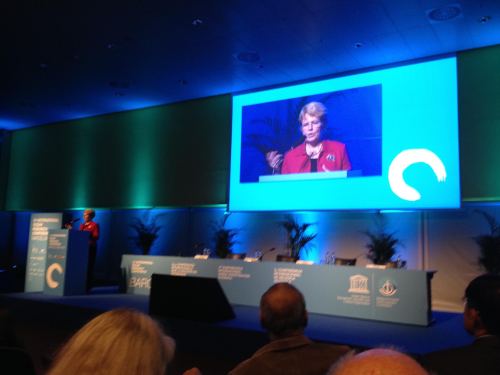Ocean research perspectives gleaned from ‘One Planet One Ocean’ conference in Barcelona, Spain - Part 1
Bill Dennison ·There were several themes that emerged at the 2nd International Ocean Research Conference, entitled ‘One Planet One Ocean’. The status and future of oceanic fisheries were a major theme, both with plenary speakers and in panel discussions. Another theme was the emerging threat of plastics in the ocean, both the macroplastics that form floating ‘garbage patches’ in the oceanic gyres and the nano and microplastics being discharged from human activities. An exciting theme was the increasing use of technology to sample the ocean, with a dizzying array of floats, drones, wave riders, remote operated vehicles, etc. that are employed to probe the remote regions of the ocean. Science communication was another theme, apart from my talk, which resonated throughout the conference, and the use of citizen science was an aspect of science communication that was discussed. Each of these themes will be discussed below.
Oceanic fisheries. There were two stellar plenary talks about fisheries by two of the top science communicators in the world: Jane Lubchenco and Daniel Pauly. The keynote plenary talk by Jane Lubchenco, former NOAA Administrator, addressed fisheries issues with examples of fishing smarter, not harder to achieve a more sustainable fishing effort. Jane stressed the importance of changing the social and economic incentives to create the feedbacks that increased the wise stewardship of fisheries resources. Rights-based fishing, which restricts the fishing effort to select people, can lessen the tendency for overfishing. Setting Individual Fishing Quotas (ITQs) provides a dedicated share of the scientifically determined total catch to fisher, communities or cooperatives. Jane spoke about successful global examples that include the US Pacific ground fishery, Belize shallow reef fisheries, Namibian hake and Denmark’s pelagic and demersal fisheries. Jane also talked about the use of no take areas (= fish banks) and the Illegal, Unregulated and Unreported (IUU) fisheries worth $10-23B annually that needs to be addressed.


Daniel Pauly from the University of British Columbia also addressed oceanic fisheries. Daniel talked about how oceanic fisheries are expanding offshore, deeper, and southward. He has documented the mean trophic level of fisheries declining (coined ‘Fishing down the food chain’). Daniel presented a bold proposal, promulgated by the Global Ocean Commission, to close all high seas catch (beyond the exclusive economic zone extending 200 miles from shore), which he posited would lead to more social equity in catches and would lead to a larger overall catch. Daniel addressed the role of climate change on fisheries, leading to a polarward shift of species distribution due to oceanic warming. On a global scale, Daniel and his colleagues predict the largest climate change impacts on polar fishes that rely on a food web based on sea ice algae (due to reduction in sea ice) and on the tropical regions where thermal stress will cause local extinctions. He estimated that the IUU fishing pressure was grossly underestimated and thinks that the world fisheries catch peak was higher and earlier than we currently believe.

During one of the panels, I was impressed to learn that while a billion people use fish as a primary protein source and a half a billion people derive their income from fisheries, only 2% of human nutrition as a whole comes from the sea. One problem that was noted was that we tend to eat terrestrial vegetables or vegetarian animals (e.g., cows, pigs, chickens), but we tend to target carnivorous fishes that are one to two trophic levels higher than terrestrial animals used for food. The trophic inefficiencies (roughly a 90% energy loss for each trophic level) means that targeting these higher trophic levels for food is one reason for the low percent of human nutrition. One of the panels advocated the use of ‘balancing harvesting’ which was to equally distribute the fishing pressure on the different trophic levels and fish sizes.
About the author
Bill Dennison

Dr. Bill Dennison is a Professor of Marine Science and Vice President for Science Application at the University of Maryland Center for Environmental Science.

